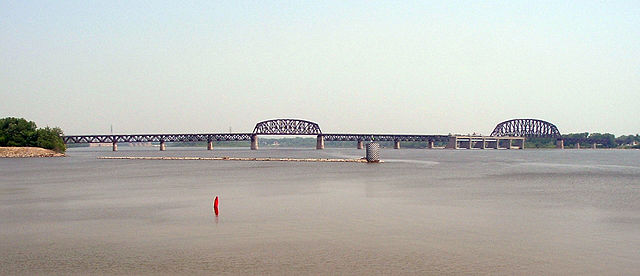Wheeling Suspension Bridge
The Wheeling Suspension Bridge is a suspension bridge spanning the main channel of the Ohio River at Wheeling, West Virginia. It was the largest suspension bridge in the world from 1849 until 1851. Charles Ellet Jr. designed it and supervised construction of what became the first bridge to span a major river west of the Appalachian mountains. It linked the eastern and western section of the National Road, and became especially strategically important during the American Civil War. Litigation in the United States Supreme Court concerning its obstruction of the new high steamboat smokestacks eventually cleared the way for other bridges, especially needed by expanding railroads. Because this bridge was designed during the horse-and-buggy era, 2-ton weight limits and vehicle separation requirements applied in later years until it was closed to automobile traffic in September 2019.

View from the Wheeling Suspension Bridge, 1977. Photo taken from City of Wheeling side, looking west toward Wheeling Island.
Photo taken from Wheeling Island side, looking east toward the City of Wheeling
Frontispiece to the Wheeling & Belmont Bridge Company's printed argument delivered to the U.S. Supreme Court in the case Pennsylvania v. Wheeling and Belmont Bridge Company, 54 U.S. 518 (1850)
Flood of 1852 – earliest known photograph of the Wheeling Suspension Bridge
The Ohio River is a 981-mile-long (1,579 km) river in the United States. It is located at the boundary of the Midwestern and Southern United States, flowing in a southwesterly direction from western Pennsylvania to its mouth on the Mississippi River at the southern tip of Illinois. It is the third largest river by discharge volume in the United States and the largest tributary by volume of the north-south flowing Mississippi River, which divides the eastern from western United States. It is also the 6th oldest river on the North American continent. The river flows through or along the border of six states, and its drainage basin includes parts of 14 states. Through its largest tributary, the Tennessee River, the basin includes several states of the southeastern U.S. It is the source of drinking water for five million people.

The widest point on the Ohio River is just north of downtown Louisville, where it is one mile (1.6 km) wide. Indiana is on the right towards the flood gates, Kentucky on the left, towards the locks. The jetty on the left is the entrance to the Louisville and Portland Canal.
Steamboat Morning Star, a Louisville and Evansville mail packet, in 1858
Built between 1847 and 1849, the Wheeling Suspension Bridge was the first bridge across the river and a crucial part of the National Road.
Cave-in-rock, view on the Ohio (circa 1832, Cave-In-Rock, Illinois): aquatint by Karl Bodmer from the book Maximilian, Prince of Wied's Travels in the Interior of North America, during the years 1832–1834







